New Boston Historical Society
New Boston, New Hampshire

War Memorial in New Boston Town Green
New Boston in the Great War 1917-1918
This year (2017) marks the 100th Anniversary of America's entry into World War I, which wasn't called World War I at the time because it was so terrible that no one believed there would ever be a second world war. It was called "the Great War", or simply "the World War".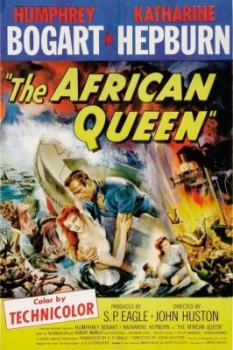 The Great War began in 1914, without the United States at first.
The Allied Powers which included Great Britain, France and Russia fought against
the Central Powers which included Germany, Austro-Hungary and the Ottoman Empire.
The Great War began in 1914, without the United States at first.
The Allied Powers which included Great Britain, France and Russia fought against
the Central Powers which included Germany, Austro-Hungary and the Ottoman Empire.
Not all of the fighting was in Europe; perhaps you've seen classic movies like "Lawrence of Arabia" with Peter O'Toole and Omar Sharif or "The African Queen" with Katherine Hepburn and Humphrey Bogart which are set in the time of the Great War. However, when the United States joined the war on the side of the Allies, most of New Boston's fighting men were sent to Europe, to fight in the trenches of France and Belgium.
The United States did not want to go to war. In fact, President Woodrow Wilson was reelected in November 1916 after campaigning with the slogan "He kept us out of war." It was a fine slogan, and if some people thought it implied "He will keep us out of war in his next term too," their mistake was understandable.
President Wilson's second inauguration was in March 1917... and America entered the war the following month! One of the reasons for this abrupt change in policy was the Zimmerman telegram, a secret message from the German Foreign Minister to Mexico which promised to return Texas to Mexico if that country sided with Germany. The telegram was intercepted by the British and shared with President Wilson, and as a consequence America declared war on Germany.
Photographs of New Boston soldiers
from Paula LeBaron's collection
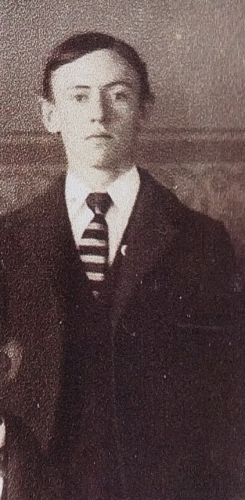
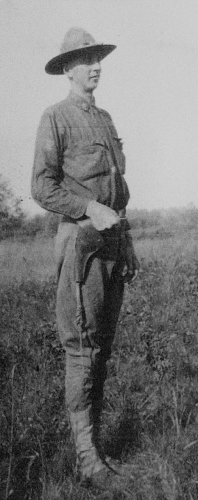

Austin Fox, Carl Pearson and Willie Leland
After the war, Willie and his family ran the telephone exchange at the bottom of Valley View Road.
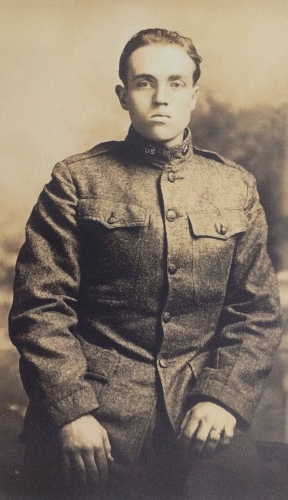

Frank Wilson and Arthur Hill
After the war, Frank Wilson worked for the post office.
Jim Dane remembers that Frank drove a Model A Ford with tracks and skis to deliver the mail in wintertime.
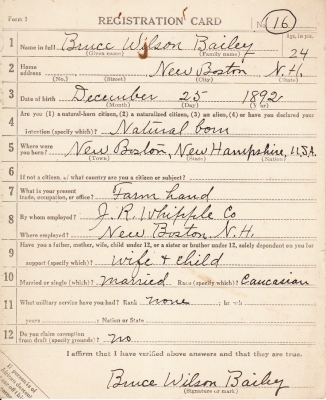 When war was declared, the first New Boston man to enlist was Austin Fox.
(It is said that the first New Boston man to enlist in the Civil War was also a Fox: namely Edmund Fox.
We don't know how or if the Foxes were related.)
When war was declared, the first New Boston man to enlist was Austin Fox.
(It is said that the first New Boston man to enlist in the Civil War was also a Fox: namely Edmund Fox.
We don't know how or if the Foxes were related.)
The Great War was not popular, so President Wilson relied upon conscription to provide the million-plus soldiers and sailors his army and navy needed. The Historical Society has a collection of draft cards prepared by Town Clerk Charles Marden.
Bruce Wilson Bailey, whose card may be seen to the left, was the twin brother of Burns W. Bailey who appears later in this page.
One of the draft cards has a notation that a certain New Boston man was ineligible for service because he didn't weigh enough! A comment scribbled on this man's card by the Draft Board demanded "more particularities".
New Boston men served as soldiers, officers, medics, cooks, wagoners, mechanics, messengers, musicians and saddlers. (Horses were a primary means of transportation in the Great War.) The enlisted men included no less than four Leland brothers, including Willie Leland, whose photo may be seen above.
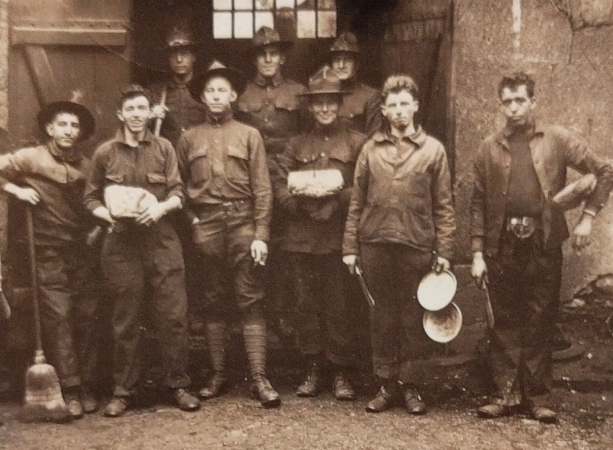

Back at home New Boston farmers worked overtime and helped one another with both manpower and horsepower to provide food for America and its allies. New Boston's primary contribution appears to have been dairy products. J.R. Whipple died in 1912, before the war began, but his Valley View Farm would most likely have had the largest herd of dairy cows.
A chapter of the Red Cross was formed in New Boston. Christmas packages and surgical dressings were prepared and sent to "our boys in service", who were especially grateful for the gift of maple sugar. Fruit pits and nut shells were collected "for the manufacture of Gas Masks". Ten bales of clothing were sent overseas for Belgian relief.
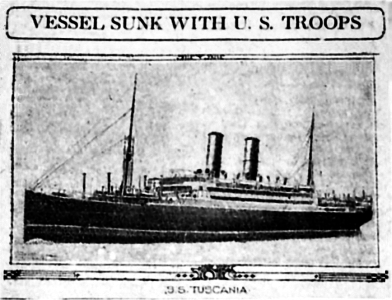
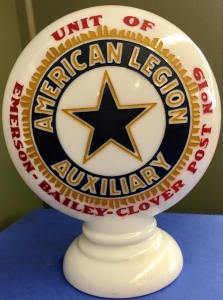
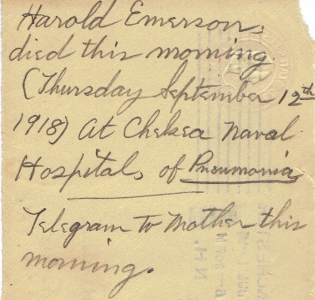
Sgt Gerald Clover was on board the troop ship Tuscania when it was sunk by a German submarine.
Harold Emerson died of influenza; the 1918 flu pandemic killed 50-100 million people worldwide.
Burns W. Bailey died in France of pneumonia a few weeks after fighting stopped in November of 1918.
The Emerson-Bailey-Clover post of the American Legion was created in their honor; it met for many years in a building near the railroad depot.
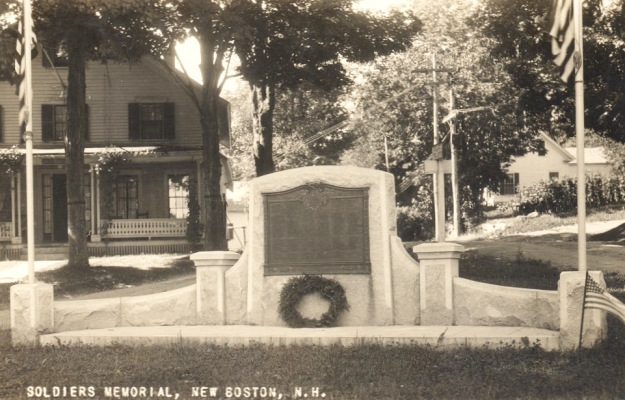
The War Memorial in its original location prior to 1947
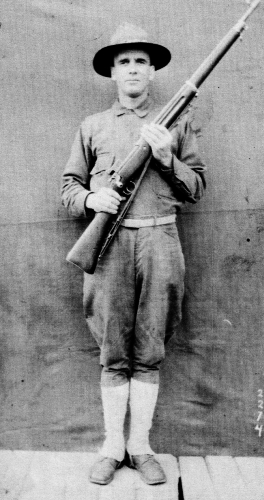 The War Memorial (see also top of page) was unveiled in 1921.
It was the idea of Eben Dodge, who was inspired by the Civil War memorials he saw in other towns
and who bequeathed $2,000 to the Town of New Boston for a monument of our own.
The War Memorial (see also top of page) was unveiled in 1921.
It was the idea of Eben Dodge, who was inspired by the Civil War memorials he saw in other towns
and who bequeathed $2,000 to the Town of New Boston for a monument of our own.
The memorial was originally situated on the other side of the bridge where the Anti-gravity monument stands today. In 1947 a new bridge was installed and a traffic circle was created around the memorial. The large granite War Memorial was relocated so that it would not obstruct drivers' vision.
Whose names are on the New Boston War Memorial near Town Hall?
• Please click here to see the names of veterans of wars up to the Great War.
• Click here for names of veterans of World War II and later wars, listed on the other side of the memorial.
The fierce-looking soldier in the photo (right) is Elkie Clement. He is not listed on the war memorial as he was a resident of Goffstown when he enlisted, but he moved to New Boston soon after the war. Private Clement was a motorcyclist dispatch bearer who served during the Meuse-Argonne offensive, the principle engagement of the American Expeditionary Force (AEF) during the Great War. Over a million American soldiers fought in this offensive, which ended when the fighting stopped on November 11, 1918.
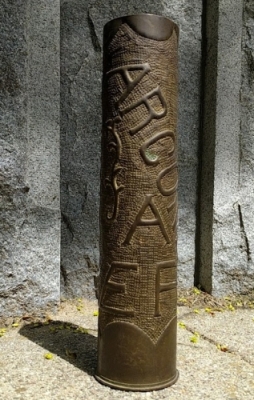 Elkie Clement lived in New Boston for many years.
A 1948 newspaper article describes an accident in which the truck Elkie was driving went off the road just south of town:
"Paul H. Saltmarsh was the owner of the truck
which is estimated to have operated nearly a half-million miles
and it is believed that the accident was caused by mechanical defects of the steering gear."
The truck was demolished; Elkie was unhurt.
Elkie Clement lived in New Boston for many years.
A 1948 newspaper article describes an accident in which the truck Elkie was driving went off the road just south of town:
"Paul H. Saltmarsh was the owner of the truck
which is estimated to have operated nearly a half-million miles
and it is believed that the accident was caused by mechanical defects of the steering gear."
The truck was demolished; Elkie was unhurt.
Trench Art
The Historical Society received an interesting gift from Sylvia Chancey while we were working on our Great War web page. The 14-inch tall flower vase (left) made from a brass shell casing is a fine example of World War I "trench art".
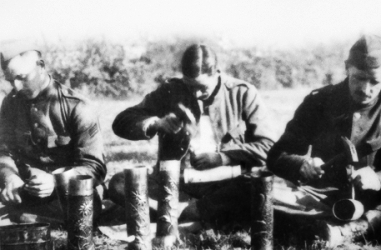 What is trench art?
During the Great War, life in the battlefront trenches was uncomfortable and often monotonous (when bombs weren't falling),
so soldiers relieved the boredom by making things from any material that was at hand.
We don't know who made Sylvia's flower vase, but it bears the inscriptions "AEF", "Argonne" and "Verdun" (not visible),
referring to the American Expeditionary Force, the Argonne forest and the town of Verdun.
The photo to the right shows French (or Belgian?) soldiers making trench art in the Great War.
What is trench art?
During the Great War, life in the battlefront trenches was uncomfortable and often monotonous (when bombs weren't falling),
so soldiers relieved the boredom by making things from any material that was at hand.
We don't know who made Sylvia's flower vase, but it bears the inscriptions "AEF", "Argonne" and "Verdun" (not visible),
referring to the American Expeditionary Force, the Argonne forest and the town of Verdun.
The photo to the right shows French (or Belgian?) soldiers making trench art in the Great War.For more information, see Janice Brown's blog post "New Hampshire's WWI Trench Art" in her "Cow Hampshire" blog.
Armistice Day
The people of New Boston were jubilant when the fighting stopped on November 11, 1918. Bells rang and whistles blew. The railroad men tied to their locomotive every flare they could find and the train arrived at the depot all aglow. "The War to End All Wars" was over at last!
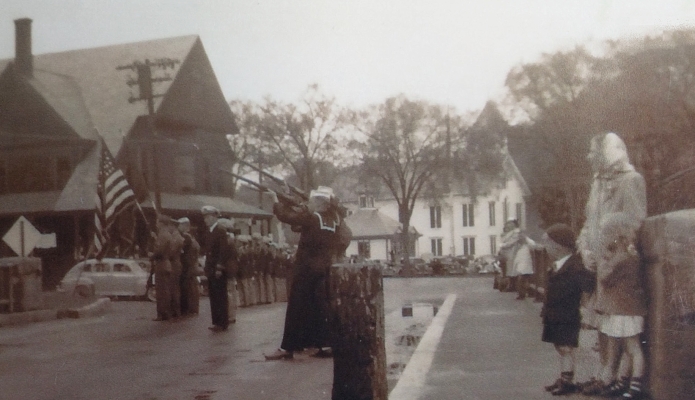
New Boston Memorial Day - 1948
